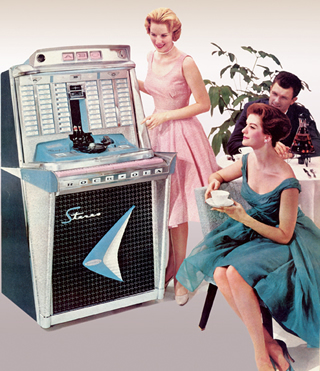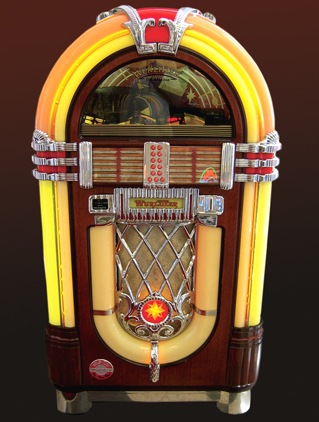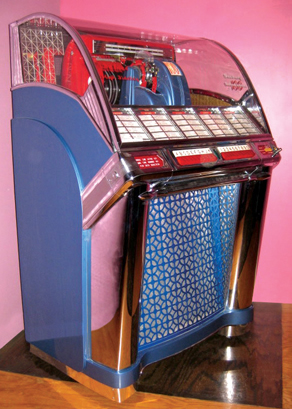The Box that Rocks - Page 5
Four to Adore
1. Rock-Ola Tempo Rock-Ola, one of the industry’s big four producers (along with Wurlitzer, Seeburg, and AMI), bragged about its attention to sound. The Tempo, labeled ‘stereo,’ could play monaural disks as well. One model, the Regis, even played in ‘Reverba-sound,’ for “vibrant, living realism.”
2. Wurlitzer 1015 “It came out immediately after World War II and reflects all the effervescent optimism of a nation celebrating a hard-won victory,” Glenn Emery wrote in the Washington Times in 1989. It’s called the ‘Bubbler’ because its heated ‘bubble tubes’ produces a colorful, ever-changing display that was described as “liquid fire.” The 1015, “the single most popular jukebox of the light-up era,” according to Vincent Lynch and Bill Henkin’s Jukeboxes: The Golden Age, was designed by Paul Fuller, who’d created the world’s first light-up jukebox, the Wurlitzer 24, nine years earlier. The 1015, as an immediate postwar creation, still has a curvaceous, Art Deco look as resplendent as any of the era’s cinematic palaces. Although built for 78s, conversion kits later made it possible for operators to convert the 1015 for 45s. In the 1980s, so popular was this machine, Wurlitzer marketed a replica.
3. AMI Continental It’s one of the best of the early 1960s designs, and could play up to 200 tunes. “Truly the style of tomorrow,” AMI promised. The Continentals were available in mono, and in “exclusive 3-channel stereo,” the firm promised. Stereo, at the time, was a recent innovation in recorded sound. “The Continental is just a beautiful object,” says Dennis Lynch, who keeps one in his Eichler in the city of Orange. “It’s the jewel of our living room.”
“It’s one of the classics, one of the most popular ones,” Dave Arango brags about the Seeburg model 100C that sits like a lord in his Eichler living room. The model first came out in 1952, marking Seeburg’s 50th year in the business.
One of the more iconic jukeboxes, the 100C was featured along with the Fonz in the TV series Happy Days—in the opening credits, no less. “One of the prettiest and yet most understated jukeboxes of all time,” Christopher Pearce wrote in Vintage Jukeboxes. Seeburg, a true jukebox pioneer, introduced the first 100-selection machine in 1948. Its 100-series models, starting in 1949, “represented the emergence of the modern jukebox,” Pearce wrote. What designer Nils Miller produced was “the jukebox, stripped to essentials,” following the modernist adage ‘form follows function.’ Seeburg was also the first jukebox maker to switch from 78s to the brand new medium of 45-rpm disks, before the 45s acceptance by the market was assured. The 100B, from 1950, was the first to play 45s, according to Pearce. One of Gerry Parson’s Seeburgs is a 100G (pictured here), from 1953, which has better sound than its predecessors. “For the G,” Parson says, “Seeburg more than doubled the size of the selector buttons, and spread them out, and noticeably enlarged the glass dome for better viewing.” Seeburg’s 100 series was also admired for fully exposing its advanced record-changing mechanism, the Select-o-Matic 100. “The public will thrill to watch the mechanical brain play 10-inch and 12-inch records...” Seeburg promised, and the promise was fulfilled. With its mirrored wall and glowing plastic pillars with “a constantly changing pattern of soft lights,” in Seeburg’s words, reflecting off a central metal grille, the 100 puts on quite a show. One of Gerry Parson’s Seeburgs is a 100G (pictured here), from 1953, which has better sound than its predecessors. “For the G,” Parson says, “Seeburg more than doubled the size of the selector buttons, and spread them out, and noticeably enlarged the glass dome for better viewing.” Seeburg’s 100 series was also admired for fully exposing its advanced record-changing mechanism, the Select-o-Matic 100. “The public will thrill to watch the mechanical brain play 10-inch and 12-inch records...” Seeburg promised, and the promise was fulfilled. With its mirrored wall and glowing plastic pillars with “a constantly changing pattern of soft lights,” in Seeburg’s words, reflecting off a central metal grille, the 100 puts on quite a show. |








